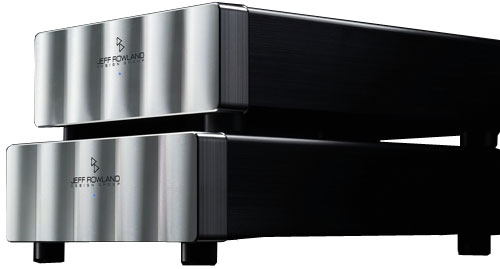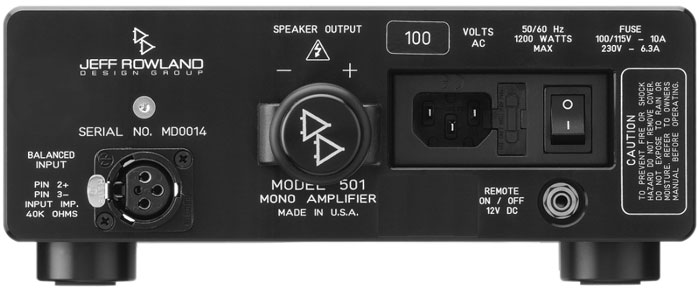With a perfect face, a killer body and an ultra sexy voice, I would like to introduce America’s next Top Model… Jeff Rowland 501! You say, “That’s NO model!” I reply, Oh, yes it is; it’s got my vote for top model of Class D amp! As for Jeff Rowland, he is a gentlemanly designer who might be better off modeling Levis 501’s rather than be America’s Top Model. However, his 501 mono block amps are among the sexiest, most “talented” sounding Class D amps I’ve come across.
Class D is what makes them very interesting. Jeff has been known for decades as a consummate amp builder. His gear oozes opulence (that doesn’t sound good, but it is!) and distinction. Historically, his name has not been associated with chip amps, but if they hear the 501’s I’m sure they will. This is a breakthrough product, as it uses newer technology in a manner that enables it to play on the same field as refined class A or A/B amps.
“Chip Amplifiers” (Class D) are making high-end audio more fun in a powerful way. Silly huge amounts of power can be put at the owner’s fingertips – in this case, one thousand Watts! A power rating like that would be nearly unthinkable in class A/B terms, as is evidenced by the fact that proportionately fewer of them exist. The beauty of Class D is their lighter, more compact and efficient mannerism. From what I’m hearing, it seems in the near future many amps will sport much larger power specs produced by modules.
As with any new technology, many audiophiles will wonder, “Is it the real deal?” That is, will it sound like class A or A/B amps? It’s an interesting question, since there is no decree that those designs must forever remain the standard by which the finest audio reproduction takes place. With a blink of an eye, a new patent, a novel technology, the standard can shift. I have no doubt that within 5-10 years chip amps will make terrific inroads into audiophile systems – the technology holds that much potential. Hearing the 501’s, I am convinced the technology is on the verge of achieving this.
The 501 is drop dead gorgeous; a brushed aluminum face plate as thick as a man’s portion of prime rib, a wave-like brushed finish which appears as ripples frozen in the metal creates an understated elegance – a finish that won’t rub off of either the casing or the owner’s pride. Aside from the moniker, the front contains precisely one feature, a blue pinpoint power LED which shines like a star sapphire. The black anodized aluminum body carries the wave effect throughout the entire piece.
Simplicity also marks the functionality of the 501, being a mono block with one balanced input and one speaker binding post. This Cardas post is a bit unusual as it utilizes a single post with a block that cinches down on both the positive and negative cables (two sets of spades can be accommodated for bi-wiring), but with use, it becomes second nature. It accommodates only spade terminations and takes a bit of concentration to fit two pair for bi-wiring, but once placed they are held in a vice-like grip. It is tricky enough that I wouldn’t want to be wrestling truly stiff cables and trying to insert two pair of them simultaneously. A protective plastic barrier vertically separates the spades so that no contact, or shorting, is possible when they are in position – a very good thought. Other features on the back include a remote trigger, fuse compartment, detachable IEC, and lastly the power switch.
The subject of this review is the set of 501 monos, however Jeff sent me the Capri preamp as a complement to the amps. With a similar finish, this small chassis pre has a lot packed into it: one pair each of balanced and single-ended inputs, both balanced and single-ended outs, HT BYPASS, PHASE INVERSION and MUTE function. The giant lime green LED readout clashed with the blue pinpoints of light on the 501 amps, but this is a minor quibble. I was grateful that Jeff used such a bright, generously proportioned display; it is one of a very few that are entirely legible from my listening chair approximately 10 feet away.
The ICEpower™ technology inside the 501 derives from Dr. Karsten Nielsen Ph.D., a Danish designer. In 1994 he used a government grant to develop a more efficient power technology for amps. Bang & Olufsen (known as B&O) made a significant investment in the resultant company, ICEpower. The 501’s use the ICEpower module. Class D chip amps (not to be confused with true digital amps) like ICEpower, Tripath and H2O are opening up a new world of extreme power for the average listener. Previously, with class A/B, very few 1,000 Watt designs were available and they were priced into the ionosphere. The rank and file audiophile can’t afford mega buck amps – $10k is still beyond the pale of most enthusiasts. But the 501 offers authentic hope that in years down the road trickle down effect will bring into view much more affordable power. Jeff is already bringing several aspects of primo amplification into financial reach with these $7k per pair specimens.
The playing field for the audiophile game in terms of power ratings has certainly lengthened these days. While low-power amps can only go so far downfield in terms of output, “going long” on power seems easy for Class D, except temporarily regarding the constraints of the marketplace. It certainly does seem like manufacturers are trying to go end-zone to end-zone, forsaking hundreds of watts for thousands. I’m usually open to entertaining the suggestion that more can be better, so when I heard that Jeff had a 1,000-watt (One grand of grand and glorious Watts per channel!) mono block I couldn’t resist it!
“With the 501’s petite power consumption, one does not have to obsess over the energy wasted achieving that Kilo of Watts.”
In an age of energy consciousness, it’s great that the development of Class D products is being accepted. With the 501’s petite power consumption, one does not have to obsess over the energy wasted achieving that Kilo of Watts. Whereas most traditional amps draw a lot of current (i.e. 150w and must keep it stored for dynamics in music) the class D amp draws constantly varying amounts of current, only “loading up” when the music calls for it. This process is inaudible to the ear in the same manner that film footage runs thousands of individual pictures past our eyes too rapidly to be discerned.
Operating The 501
What can be discerned is the absolute sense of ease and depth to the amp’s ability to provide clean power on demand. The 501’s have a very smooth run up to their “power stroke” at the higher end of their potential. I found that it took well past 50.0 on the Capri’s readout, in a range from 0.0 – 100.0, in half decibel steps, to get to the moderate level playback that I enjoy. However, push much past 60.0 and the level fairly explodes. Anyone who has tried pushing them will know that Class D amps will simply not run out of juice like A or A/B designs! The slow ramping of power combined with the lightning fast stepping works well. I never found myself playing games with the remote attempting to make adjustments, and I never recoiled from a bombastic leap of the level. The volume control on the face of the unit is speed sensitive so that a slow turn will advance or rescind the level slowly, while a quick turn picks up the rate rapidly.
Speaking of adjusting, the remote is classically elegant and functional, a flat grey elongated oval metallic casing reminiscent of a sickly oversized Tootsie Roll with diminutive silver buttons. It’s a good thing it isn’t brown! The functions, aligned vertically, are INPUT, MUTE, VOLUME UP/DOWN, and BALANCE L/R, the last being a function which hints that the remote is pressed into service for more than one preamp. Thankfully, Jeff knows that many music listeners, including me, do not want to be accosted by complex handheld devices when relaxing to music. A very satisfying mechanical click is heard as the soft switching is conducted inside the unit. Upon start up, the preamp stays in protect mode for two seconds, then more softly clicks as it switches on fully.
I am grateful that further protection has been built into the 501’s. It can be very difficult to see the blue power indicators lit up in a bright room. On one occasion, I moved the 501’s back onto my equipment rack after a very brief rest (these amps spent a lot of time running in my listening room, as their power and detail is impeccable.). Halfway through the reintroduction, as I was reattaching the speaker cables, I was horrified to see that one of the amps inadvertently had its rear power switch toggled to the “On” position, most likely when I was positioning it. The petite pop made when the amps turn on is so soft that I missed it entirely. Neither the pinpoint of light, nor the pipsqueak pop alerted me to the status of the amp. Needless to say, I was ecstatic that Jeff had power protection built into the amps. Potential owners should take note, as this amp, even though loaded with power, is all about subtlety. One needs to be sharp and alert when laboring over Rowland equipment.
Burn-in was as close to a verifiable reality with the Rowland 501’s as with any piece of gear I have used. Often running amps, CD players, etc. does not result in significant enough changes to pass my Law of Efficacy. If a component change yields an immediate, distinct difference in sound, it passes the law and should be considered as efficacious. If not, there’s no point in wasting time over it, unless in the final stages of fine-tuning a system with which one is largely happy.
“… they would eventually sound so palatable that I would hold them second in enjoyment only to my Pathos Classic One MkIII’s, which are tube hybrid integrateds.”
Initially, I was not overwhelmed with the experience, and I felt the amps were too pedestrian, too much like the inexpensive Channel Islands D-200 monos I reviewed. However, after a solid 200 hours of break-in, either I got used to them or they got better. Either way, I was swayed to enjoy their sound, and that perception never wavered after that point. In the way that a new sweatshirt had become more comfortable after a few washings, the 501’s seemed to soften a bit. In fact, they would eventually sound so palatable that I would hold them second in enjoyment only to my Pathos Classic One MkIII’s, which are tube hybrid integrateds.
- (Page 1 of 2)
- Next page →



Hello How wonderful is this demonstration on Jeff Rowland’s 501, be enchanted by the new technology and performance of this wonderful machine !! when I buy a pair I will be very happy !! Domingos Savio.
Natal RN-Brazil
hug